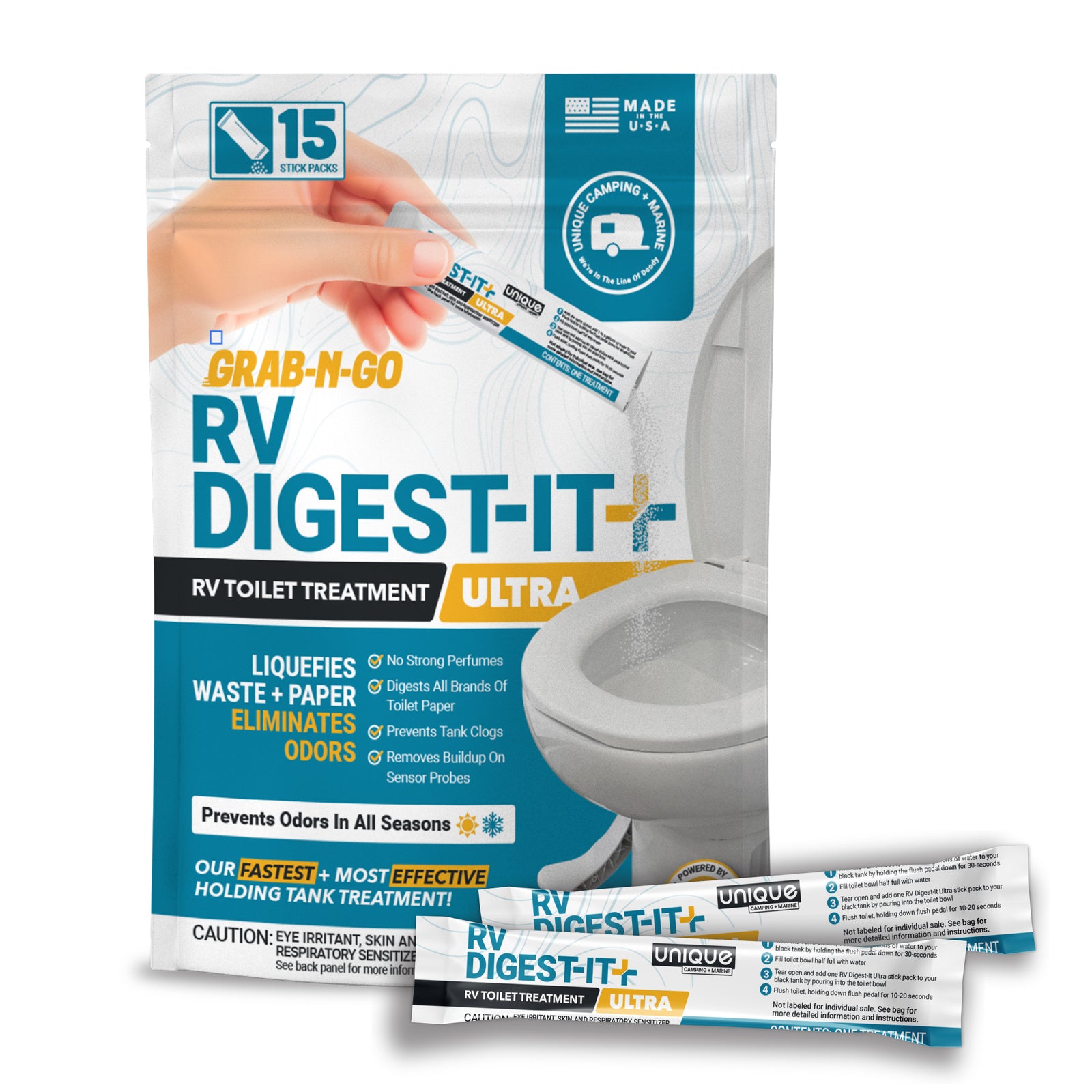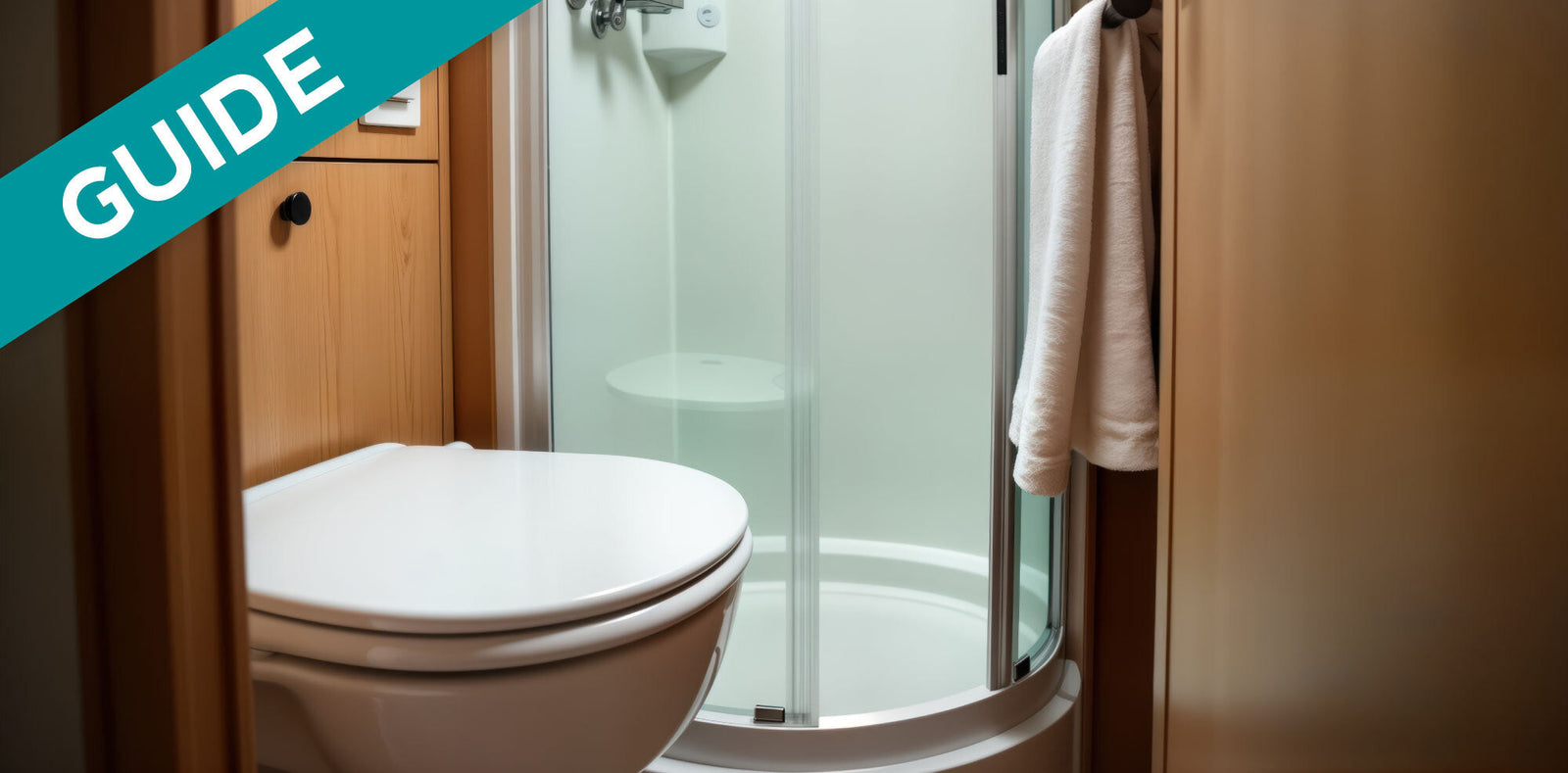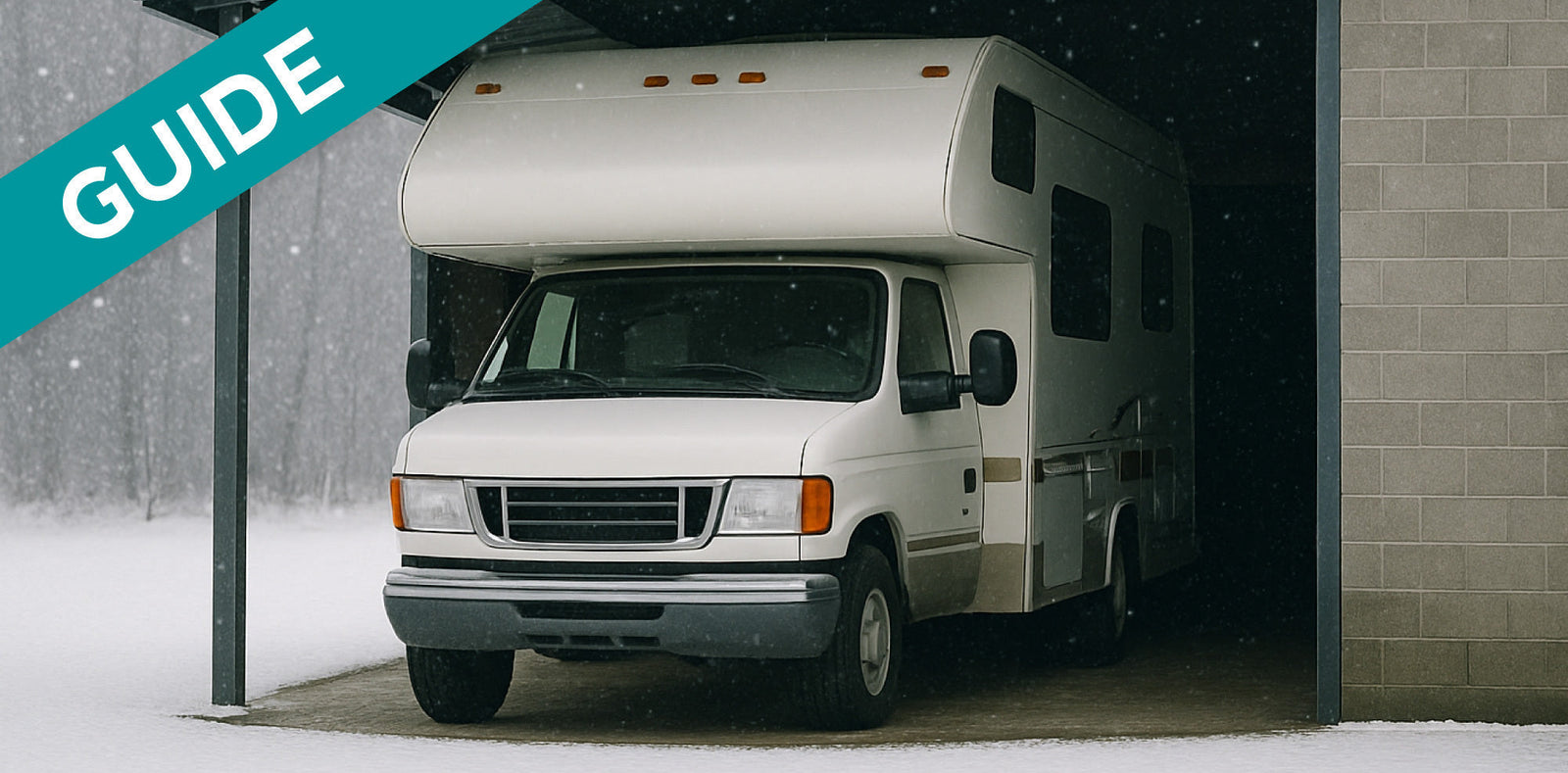
View printable version of this guide.
Disclaimer: Our recommendations when it comes to using your wastewater holding tanks are based on 40 gallon or more holding tanks. RVers with smaller holding tanks should adjust for the size of their tanks.
Key Points:
- When using your black and gray tanks full time, it’s extra important to treat them with a high-quality bacteria-based treatment.
- Always keep your black valve closed whether you are on hook-up or not.
- Use your gray tank properly when on sewer hook-up: keep the gray valve open, create a p-trap in the sewer hose, and don’t let any solids in.
- While boondocking/dry camping, always keep your gray valve closed, treat your tank with a bacteria-based product, and prevent grease and food solids from getting into the tank as much as possible.
- Adopt The Unique Method habits to get the most problem-free experience.
As a full time RVer, it’s vital that you properly maintain your RV waste water systems, not only because you want to avoid disgusting odors, but also because prevention is the best defense. It’s always better and typically requires less energy and time to avoid a problem than to have to deal with it later. There’s quite a bit of misinformation out there regarding the best ways to treat your tank while living in it full-time, so we’ve developed this easy-to-follow guide that will teach you how to effectively treat your black tank and gray tank as a full-time RVer.
Treating Your Black Tank While Full Time RVing
As a full time RVer, the two most likely issues in your holding tanks are: odors and waste accumulation. The best tank treatment for black tanks is a bacteria and enzyme product (like Unique RV Digest-It Plus) that will take care of these issues all at once. Perform the following steps after each dump:
- After dumping your black tank, use a rinser wand or your built-in back-flusher to thoroughly rinse the tank; run the built-in rinser, back-flusher attachment, or rinser wand until only clear, fresh water is coming out of your discharge hose.
Note: Perform a thorough rinse after every dump.
- Close your black tank valve.
- Add several inches of water to your toilet bowl.
- Shake the Unique RV Digest-It Plus bottle (if using liquid) thoroughly before each use.
Note: Bacteria in liquid settle to the bottom over time, and to ensure that the correct amount of bacteria is added, the product needs to be well mixed before each treatment.
- Pour 2 ounces (or one drop-in/scoop of powder) of RV Digest-It into your toilet bowl.
- Flush your toilet.
- Add several inches of water to your toilet bowl, and get back to your day.
- Repeat these steps each time you dump your tank, whether you are on hook-up or not.
Treating Your Gray Tank While Full Time RVing
Everyone has differing ideas on how to properly treat a gray water holding tank. For full time RVers, the method you ultimately choose is your decision, and it should be based on how you routinely camp. What follows are our gray tank treatment recommendations when using RV Digest-It Plus and full-time camping.
While on sewer hook-up, leave the gray tank valve open
RV full timers who camp on sewer hook-up should keep your gray valve open. We know this goes against the grain for some of you who’ve been properly trained to always keep your black valve closed, but your gray tank should be treated differently when on sewer hook-up. In addition to your tank never filling to capacity, leaving your valve open for gray water to immediately drain to the sewer will help keep sensors free of oil and grease and working properly. When greasy, soapy water continually rises in a gray tank with the valve closed, sensors can become coated with the greasy film and misread, but the water will never get high enough to do that if you leave your gray valve open while on hook-up. There are still some treatment processes to consider whether you leave your valve open on hook-up or need to leave it closed, which are described in the Full-time RVing with Sewer Hook-up and Full-time RVing While Dry Camping/Boondocking sections below.
Put a p-trap in the discharge hose while on sewer hook-up
A p-trap is just a dip in the sewer discharge hose so that there is always a small amount of water in the line to block sewer gases from wafting back through the hose and into your RV. These gases can be dangerous to your health as they contain methane, so consider getting the tools you need to always have a p-trap in the line.
Important: In some states, you are required by law to keep your discharge hose off the ground and failing to do so is punishable by hefty fines. Not knowing this can cost unsuspecting RVers their hard-earned money, so please make sure you are aware of all local laws and regulations and collect the tools you need to comply. You can still have a p-trap when you are camping under these rules, but the p-trap must also be off the ground.
Don’t let any solid waste into the gray tank
The majority of the waste going down your sink, shower, or dishwasher drains should be liquid, so clogs should not be a concern. It’s important to never let solid food waste or any other type of solid waste into your gray tank. But even large amounts of grease (which are technically not solids) can still cause lots of problems, so still strive to limit the amount of grease that goes into your gray tank as much as possible. Here are some ways you can prevent those things from reaching your gray tank:
- Wiping your dishes well before washing
- Using a sink strainer
- Using paper plates (skip the washing altogether)
Treat your gray tank with Unique RV Digest-It Plus
We know, you thought Unique RV Digest-It Plus was just for black tanks, but it benefits gray tanks too! If you are full-timing it and are not on sewer hook-up, treating your gray tank can relieve tank headaches before they ever develop. Most dishwashing and hand soaps are antibacterial, but this is not what you want to use if you are treating your gray tank with RV Digest-It; antibacterial soaps will kill the bacteria you’re adding with RV Digest-It. We recommend washing your dishes and hands with Dawn Ultra dish soap because it has great grease-fighting power even in the holding tank (which is why we also recommend it as your gray tank deep cleaning solution), but there are things that can still invade your gray tanks, like food debris, that Dawn Ultra cannot address. No matter how well you strain your drain or wipe your dishes, bits of food debris can still find ways to get past your barriers. RV Digest-It will begin to break down these solids so clogs will never become an issue. The bacteria from RV Digest-It Plus will also help control the foul odors that can develop in a gray tank; yes, sometimes gray tank odors can be worse than black tank odors!
Guide: Why You Should Use a High-Quality Waste Digester in Your RV
Important: Only use tank treatments in your gray tank when dry camping/boondocking where you must keep your valve closed; no tank treatment is necessary when you keep your gray valve open on hook-up. If you add treatment while your gray water valve is open, it will just run into the sewer and your tank will not benefit at all.
Full Time RVing with Sewer Hook-up
When camping on sewer hook-up, you need to know the correct ways to use your tank valves because there is a slight variation in how you would use them while dry camping or boondocking.
Black Tanks
Let us reiterate again the importance of keeping your black water valve closed even if you are on sewer hook-up. Keeping the valve open is a recipe for pyramid plugs and other problems that are easily avoided by just closing the valve when not actively dumping a full tank. This means that whether or not you are on sewer hook-up, treating your black tank with a good bacteria and enzyme tank treatment (like Unique RV Digest-It Plus) is necessary to break down waste and control odors. This type of treatment is the best way to combat clogs, odors, and misreading sensors all at the same time.
Guide: Why It's Crucial to Keep Your RV Black Water Valve Closed
Gray/Galley Tanks
When on sewer hook-up, it is actually better to keep your gray valve open. Consider what happens in the gray tank when dry camping or boondocking. You keep your valve closed, which means that every time you use the shower or use the sinks for washing hands or dishes, you are adding soapy, greasy water to the tank. Every time you do, the overall water level slowly rises, which means that floating grease and soap have plenty of time to cling to sensors, potentially leading to misreads. Leaving your valve open on hook-up allows greasy water to immediately flow into the sewer, foiling the chance for that grime to stick to sensors. Built-up grease can still be present in the drain lines and on the tank floor even while leaving the valve open, which is why we highly recommend performing a simple, once-a-week procedure to remove that build-up and prevent odors.
- Keep your gray tank valve open during the week, and use normally.
- Once per week, close your gray valve and fill your kitchen sink with warm water.
- Shake the RV Digest-It Plus bottle very well, and pour 2 oz of it into the sink.
Note: Bacteria in liquid settle to the bottom over time, and to ensure that the correct amount of bacteria is added, the product needs to be well mixed before each treatment.
- Release the water so it drains into your gray tank.
- Use your tank normally until it reaches capacity.
- When it’s full, open your valve and dump your tank.
- Leave the valve open for a week and then repeat this process regularly.
Remember, tank odors can also come from a discharge line that doesn’t have a p-trap in it; you may just have sewer gases invading because you don’t have a p-trap instead of odor-causing grease and grime. You may also need to perform a deep cleaning on your gray and/or black tanks; built-up waste that isn’t cleaned out with regular deep cleaning can also cause odors.
Full Time RVing While Dry Camping/Boondocking
If you are dry camping or boondocking full time and don’t have any-time access to sewer hook-up, it’s crucial that you use a waste treatment product in both tanks to control odors, prevent clogs, and keep your sensors in proper working order.
Black Tanks
Using a high-quality bacteria and enzyme treatment product in your black tank is extra important when boondocking because you want the solid waste in the black tank to be as liquified as possible to make dumping easy and hold as much waste as possible before dumping. We understand that boondockers tend to conserve water and not allow as much in either tank so they can go longer without dumping wastewater tanks and refilling freshwater tanks, but avoiding clogs is probably a better goal than a prolonged dumping timeline. This is especially important when camping in high heat to control odors and clogs. Using more water and a good bacteria treatment product (like Unique RV Digest-It Plus) will help combat all potential issues whether the heat is high or just right.
Note: View the guidelines described in The Unique Method as it all applies to full-timers as well.
Gray/Galley Tanks
Not to beat a dead horse, but as we’ve said before, being on sewer hook-up means you don’t need to add treatment products to your gray/gally tanks, but it is crucial when boondocking. As the overall water level slowly rises in the gray tank, floating grease and soap get extended chances to cling to the sensors, potentially leading to misreads. The most effective routine things you can do for your gray tank while full-time dry camping/boondocking are:
- Treat the tank with Unique RV Digest-It Plus after every dump
- Wash your dishes and hands with non-antibacterial soap (like Dawn Ultra)
As we mentioned earlier, RV Digest-It and antibacterial soaps do not mix well. Antibacterial soaps will kill the bacteria you add with RV Digest-it, so carefully consider which hand soaps and dish soaps to buy to make sure it will not negate the breakdown power of the bacteria. We recommend Dawn Ultra because it does not harm the bacteria and it is one of the best grease-cutting soaps out there, meaning every time this soap goes down your drains, it will help break up grease in the pipes and in the tank.
After dumping your gray/galley tank, complete the following steps to treat your gray tank:
- Fill your kitchen sink with warm water.
- Pour 2 oz of RV Digest-It Plus into the sink.
- Drain the sink water.
- Repeat regularly once per week, after every dump, or when you smell tank odors.
Note: Regular deep cleanings (every 5-10 dumps for full-timers) will help keep tank odors at bay.
Best Holding Tank Habits For RV Full Timers
In general, full-timers can follow the guidelines of The Unique Method and get lots of great benefits, but certain aspects of the process need to be slightly modified to accommodate the need for using holding tanks full time. Here is a review of The Unique Method habits with a little tweak or two for the full-time RVer:
- Always keep your black tank valve closed (unless dumping a full tank). Even for full-timers on sewage hook-up, this habit still applies. If you leave the valve open all the time, liquid waste will immediately flow out and solid waste will have no liquid to help it flow to the sewer; it will instead build up right where it falls, increasing the potential for clogs.
- Always keep several inches of water in your toilet bowl when your RV is stationary. This will act as an odor barrier to keep sewer smells from backing up into your RV. Whether on hook-up or not, odors can still rise into the living space, and if you’re living in your RV full-time, that is definitely something you want to stop before it ever starts.
- Always flush your RV toilet with water for at least 10 seconds. Adding this much water with every flush will help the good bacteria that break down and deodorize your holding tank to stay well-hydrated and cool, something that is crucial whether you’re on full-time hook-up or boondocking.
- Keep your tank temperatures between 45 and 85 degrees Fahrenheit. Aerobic bacteria (the good kind) need cooler temperatures to function at their highest level and lots of water is the best way to keep the tank cool. We recommend adding water or ice to your tank if you believe temperatures are exceeding 85 degrees. For full-timers who are on sewer hook-up, adding more water to the black tank shouldn’t be a problem because you can dump the full tank whenever you need to, but full-timers not on sewer hook-up may want to weigh the odor risks of not adding water or ice to cool down the tank against the inconvenience of moving your rig to dump. A great way to know exactly how hot or cold your tanks are is to invest in a temperature gun; they are very accurate and handy for many other things as well.
- Dump your holding tanks every 5 days.We recommend this because typically it takes about that long for tanks to be completely full and dumping this often helps prevent odors and keeps tanks in good operating condition. Full-timers not on sewer hook-up should consider using lots of bacteria-based tank treatments (like Unique RV Digest-It Plus). Consistent treatment with bacteria and enzyme products and lots of water should control odors well in any environment.
- Use bacteria and enzyme tank treatments (like Unique RV Digest-It Plus) in both tanks. Bacteria-based tank treatments are always the best choice when treating your black and gray holding tanks because the specific strains of bacteria used in these products help with both waste breakdown and odors. For full-timers on sewer hook-up, only use this product consistently in your black tank. You will likely leave your gray tank valve open so all the sink and shower wastewater flows right into the sewer instead of accumulating in your tank, but treating your gray tank frequently while on hook-up can still help curtail odors. Follow the steps for treating your gray tank once a week with RV Digest-It in the Full-time RVing with Sewer Hook-up section.
- Never clean your RV toilet bowl with chemical toilet cleaners. Chemical products can damage RV toilet bowls and will kill the good bacteria that keep your black tank clog and odor free. Clean your toilets with a toilet bowl cleaner like Scrub-It RV toilert cleaner that enhances the strength of the bacteria, doesn’t cause damage, and cleans the toilet bowl at the same time.
-
Flush/rinse your black tank after every dump. This practice will help to maintain working sensor probes and ensure that no residual waste has collected in the corners of the tank, which can easily lead to clogs or odors. You may also consider performing a short rinse after every dump to get ahead of any possibility of waste accumulation in corners or residual waste being caught on sensors. You can use your built-in rinser, a backflusher attachment, or a rinser wand as all of them will perform well.
Note: Refer to our guide on How to Use Rinser Wands and Other Rinsing Tools.
- Deep clean your holding tanks every 5-10 dumps. Deep cleaning gray tanks is pretty easy while full-timing, but black tank deep cleaning is a little harder because you still need to use the facilities while Clean-It is doing it’s work. Our guide on Deep Cleaning RV Wastewater Holding Tanks provides comprehensive deep cleaning steps and modifications for full-timers.
As an Amazon Associate, Unique Camping + Marine earns from qualifying purchases.

Prevent Common Problems In Your Tanks!
From misreading sensors, preventing clogs, or eliminating odors, we've got you covered no matter how you camp! All our best holding tank tips and trick information plus more can be found conveniently in one place when you download our FREE Unique Method Field Guide PDF. Achieve holding tank bliss today!
Get The Free Download Get The Free Download



